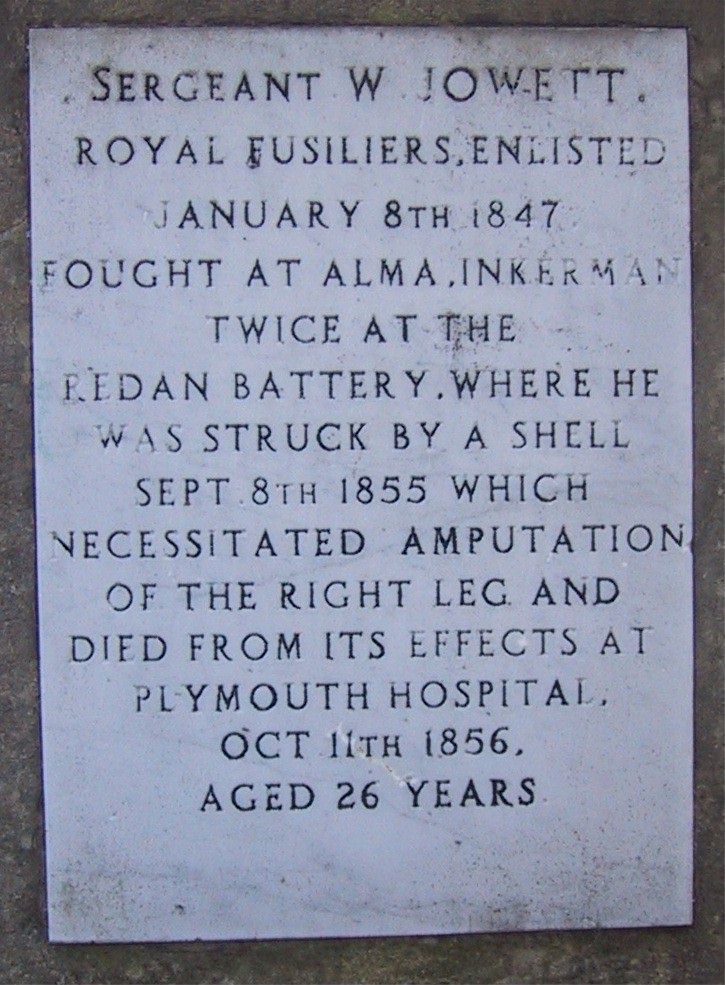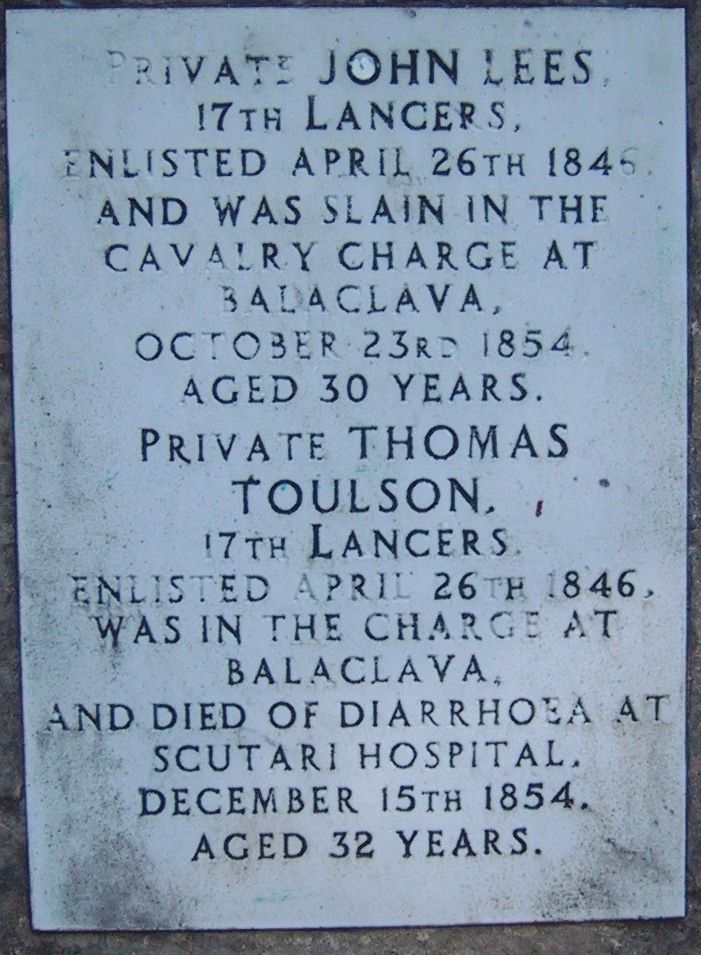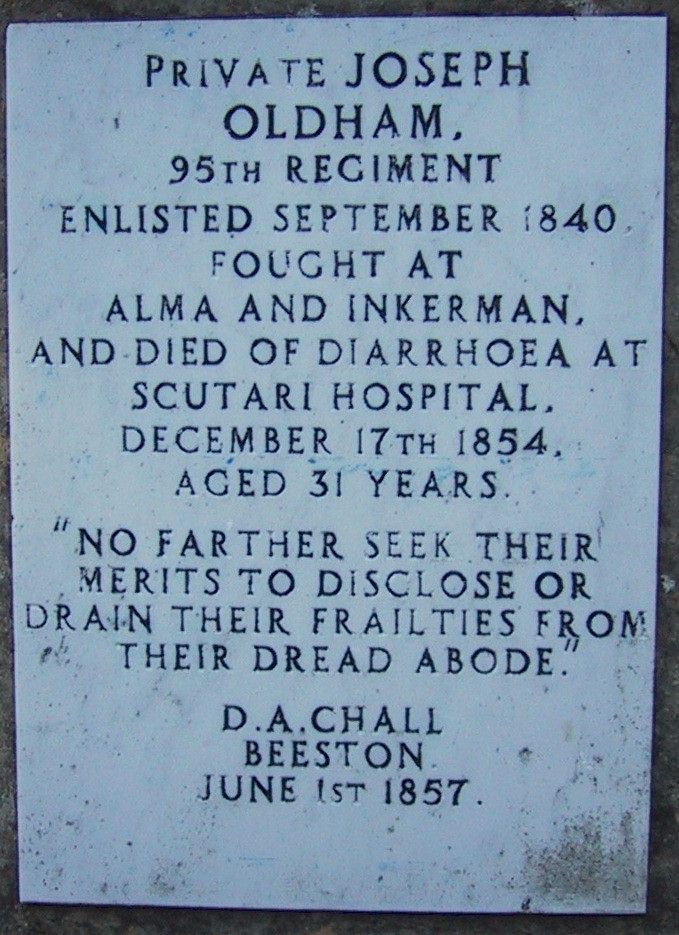| Home Topics Memorials Miscellany Transcripts References Family History Glossary Latest Beeston Blog About us | Site Search |
|
The Crimean War Memorial at Beeston -
On this page, we explore the circumstances and personal bravery that led to this expression of local remembrance which has endured for over 150 years. A Little About the Crimean War - This war began in 1853, with British and French involvement from 1854, and lasted until 1856, fought between Russia and an alliance of Britain, France and Turkey (and Sardinia from January 1855) over competing claims for influence - both territorial and religious - in the Middle East, notably the Holy Land, then part of the Turkish Ottoman empire. There were also concerns over threats to British and French trade routes in the region, from Russian attempts to control Constantinople and to establish direct access to the Mediterranean. These complex reasons are now often forgotten, with most people today remembering two memorable aspects of the war - The Charge of the Light Brigade and Florence Nightingale's heroic efforts in caring for the sick and wounded. In fact, both were symptomatic of a fundamental problem within the British Army - maladministration on a large scale which became only too apparent in the Crimea. resulting in tragic operational blunders and - even more significantly - dreadful conditions for the British troops, resulting in terrible suffering and large-scale disease. It was a war where disease - typhoid, typhus, cholera and dysentery - killed many times the number who died from battle wounds - and the resulting public outcry made this failure the legacy of the war which was remain in the public conscience for many years. Although it took over 50 years and many enquiries, change did result - particular in the field of medical care. As a result the Army was, mercifully, better able to cope with the terrible casualties from the wars of the 20th Century. The British and French expected a quick victory when they assembled their invasion force at Varna in Bulgaria. Together with Turkish troops it numbered over 60,000 troops. A principal objective was Sevastopol, the main Russian naval port and the key to naval power in the Black Sea and Russian access to the Mediterranean. Although the landings were unopposed, shortcomings in provision for the troops were immediately evident. For the first time in any war, the telegraph enabled correspondents, notably William Howard Russell for The Times, sent back graphic - and worrying - reports of shortages of tents and medical facilities and deficiencies in transport arrangements. The evident organisational shortcomings soon led to outcries at home. The first major encounter, the Battle of Alma on 22 September 1854, notwithstanding these underlying problems, and despite chaotic allied command during the battle itself, resulted in a rout of the Russian forces who fled in complete disarray - but still managed to retain control of Sevastopol. The British established themselves at Balaklava, the French at Kamiesch, both to the south of Sevastopol, in a somewhat imperfect siege of the city. Allied bombardment of Sevastopol commenced on 17th October 1854, followed by a major attack by the Russians on the 25th. There followed the Battle of Balaklava, south of Sevastopol which was to be ever remembered for the infamous Charge of the Light Brigade. Early clashes were successful in beating off Russian attacks, firstly when two companies of Highlanders fought off a Russian cavalry attack with what was graphically described as "a thin red streak, tipped with a line of steel" by Russell in The Times - a line that led to the action becoming known as "the thin red line". When the Russian forces began to regroup, a charge by the Heavy Brigade of cavalry was successful in driving them back. Their followed the infamous Charge of the Light Brigade which, characterised by a series of ambiguous and imprecise orders issued and misinterpreted by the senior command was a disaster for the 673 men who were decimated by Russian artillery arranged on the hills on both sides of the valley in which they charged; over 100 of their number died. On 21 October 1854, Florence Nightingale headed a team of 38 volunteer nurses to the Crimea. At the barrack hospital at Scutari, she found extremely bad conditions, a shortage of medicines
and medical supplies, hygiene being neglected and poor food and catering. Not surprisingly, infections were common and often fatal. She set about establishing better standards of cleanliness and patient
care but the understanding of the cause of infections was not fully developed and it was not until some six months later, after the sewers were flushed and ventilation improved, that her efforts were
rewarded with a dramatic decline in patient mortality. Later, using her interest in statistics, she was able to make the link between disease and lack of cleanliness which she was able to use to help
change attitudes to care in Army hospitals and in their design. This was to have an important, long-lasting effect within the Army and beyond. At Balaklava, the Allies had lost ground but the Russians had failed to make a breakthrough. On 5th November 1854, they made a surprise attack on the British, in foggy conditions, in what became known as The Battle of Inkerman. This battle, characterised by the fierce nature of its hand-to-hand fighting became known also as the "Soldiers' Battle" because of the almost total lack of high command. Nevertheless, after a day of fierce fighting, late assistance from the French and very heavy Russian casualties, the British held the field In the winter that followed, the failures of provision of food, shelter and medical supplies were cruelly pronounced and many died of exposure, malnutrition and sickness. Although supplies did begin to arrive later in 1855 they were too late to save the many who had suffered and died - and too late to placate public opinion at home. In the face of this adverse feeling, a vote of confidence led directly to the fall of the Lord Aberdeen's Government which had taken the country into the War and which was held ultimately responsible for the organisational failures and poor conditions. 1855 was characterised by several attacks initiated by both sides with little progress. However, on 8th September 1855, what became the final attacks on Sebastopol took place. Although the
British assault on the Redan failed, the French were successful at the Malakoff. The Crimean War was effectively at an end, a position formalised at the Treaty of Paris with Russia losing her dominance
in the Balkans and agreeing to the integrity of the Ottoman Empire. Further detail on aspects of the Crimean War can be seen (each opening in a new window - close it to return here) at: Wikipedia entry Beeston Men in the Crimea - The inscription on the front face of the memorial at Beeston reads:
The other three faces remember the four men from Beeston who were where killed in action or died of wounds or disease following action there:  

There seems little doubt that the extreme circumstances of this war - rapidly relayed, for the first time, by war correspondents - must have had a profound effect on the population back in Beeston. But it was probably the account, written so vividly in his diary by William Jowett, that brought about a determination to erect this permanent memorial to its fallen sons. While, no doubt, some - not understanding - may be tempted to smile at the description of two of the deaths, those who do understand the men's bravery and dedication, despite the conditions and the squalor, understand the reality and the awfulness they suffered. This would have been the motivation of those who were determined to remember their dead. We hope sincerely that this account assists in the same understanding and proper recognition today, of those from Beeston who served and suffered in the Crimea. This understanding of the suffering of those who fought and died would have been felt all the more by the presence amongst them of the one man from Beeston who returned from service in the Crimea, albeit severely wounded, and who was to live out a respected life as an Army pensioner in the village:
When he landed in the Crimea he was a "raw-un" or recruit, and one of the older soldiers thought he could impose on the young man from Nottinghamshire, so he stole Oldham’s rations, but, young as he was, Oldham could stick up for himself, and fought the thief for three hours until they were both black and blue. Col. Hoften coming on the scene stopped the fight, remarking "you have come out to fight for Queen and Country and not to kill each other." He was to go on to fight at Alma, was present at Balaklava. Inkerman and Sebastopol, receiving the Crimean medal with four bars and the Turkish Medal. At Inkerman, that memorable "Soldiers’ Victory," - when "7,464 English troops and 8,219 French, or 15,683 in all, defeated the Russians completely, although they numbered 120,000" - Oldham was wounded three times, but he, with his comrades, fought on through attack and counter attack; it was a hand-to-hand fight, and "one of the most memorable feats of arms accomplished by British troops - taking rank with Agincourt. Plassey, or Waterloo".
On one occasion, when Florence Nightingale herself became ill while in the Crimea, Oldham was one of a party of six from the Coldstreams who carried her to Castle Hospital. Later in life he would recall her qualities, "She was a grand lady to us soldiers, a regular mother, so kind, so gentle, and we often wondered if she ever went to sleep, because she was always at work among the sick day and night. We were glad to hear of her recovery." While serving in the trenches Oldham was severely wounded in the left foot which resulting in his discharge on a pension of 8d per day.7 He had served in the Army for 1 year 114 days. On his return to Beeston, the inhabitants of Beeston presented him with an arm chair with a suitable inscription on a silver plate. He had been very lucky to return, for after the battle of lnkerman he was the only one left in his tent, and out of 500 who marched to meet the enemy only 32 men and three officers returned. Robert married Jane Hufton in 1857 and together thay had ten children, all but one living into adulthood. He found work at the silk mill in the village. In the last years of his life he lived at 29 Derby Street, Beeston and died on 17th March 1908.8. He was buried on Sunday 22nd March at Beeston General Cemetery with full military honours. The Bearer. Firing, and Bugle party was provided by the Robin Hood Rifles and the Beeston Humber Silver Band, under Mr. J. E. Irons, joined the funeral cortege and played the Dead March. The Rev. Rufus Jones officiated. His memorial (shown right) survives in Beeston Cemetery in memorial of this Beeston hero.9 Click to read a more complete Family Genealogy of Robert Oldham Footnotes 11841 Census : Beeston Notts - Piece 856, Folio 14-44. His parents and the older children - including John - were then recorded as born outside of Nottinghamshire, possibly in Long Eaton, Derbyshire where it is known (from later census entries) that his mother was born. 21841 Census : Beeston Notts - Piece 856, Folio 13-21. The Turnpike is now High Road. His parents were born in about 1775, his father locally, his mother in Scotland. In the 1851 Census. Joseph Oldham can be found as a Private in the 95th Regiment, stationed at the Anglesey Barracks, Portsea, Hampshire. (Piece 1658 Folio 484) 3Florence Nightingale had arrived at Scutari in October but had not yet been able to control or rectify the problems, mainly of sanitation, that were then causing widespread deaths there. 4Joseph & Elizabeth are to be found in the census of June 1841, living there with their three then surving children (Piece 856 Folio 15-09); this included the 17 year-old Thomas who, like both his parents and both his siblings, was then working as a framework knitter. Thomas was baptised at Beeston Parish Church on 16th May 1824. 51841 Census : Beeston Notts - Piece 856, Folio 14-51. The Poor Row was situated to the east of the churchyard. 6His enlistment date and other anecdotes and details from Robert Oldham's Army service and his retirement are derived from an obituary published by (the Nottingham Branch of) the The Crimean & Indiam Mutiny Veterans' Association at the time of Oldham's death. 7Just over 3p in today's money - but with a present-day spending power of about £15 a week. On the recommendation of Major G Fellows, J.P., Treasurer of the Local Association, it was increased in 1900 to 10s 6d per week for life (about 52p - with a spending power of over £40 a week. 8The obituary describes him as "the last surviving Crimean Veteran left". It is not clear whether this is nationally or in the Nottingham branch. 29 Derby Street was the home of his daughter, Mary Jane Cope 9The memorial also commemorates his wife Jane (who died in 1903), his son Robert (who served in the Grenadier Guards and died in 1931) and Robert's wife, Louisa (who died in 1942) I am indebted to Frank Stanley. a descendent of Robert Oldham for making available the picture of Robert, his obituary and other related information Bibliography The Crimean War Memorial at Beeston Parish Church : published by Beeston & District Local History Society, 1996. Based on papers left by the late Wally Dunn with further research by Disney Keeble & Pamela McGrath, edited by Sheila Eden A pamphlet marking the 140th anniversery of the end of the Crimean War, with notes on the war and extracts from the Jowett diary and letters and from Robert Oldham's obituary. |
|
|||||||||
|
|
|||||||||||
 In the Churchyard at Beeston, by the path near to the Church Street entrance, stands a memorial to the men from the village who died in the
Crimean War. Memorials to that war are very unusual and this one at Beeston is almost unique in terms of its format and for a community of this
size. Elsewhere, there are larger scale memorials in more urban centres - notably in London, Sheffield, Southsea and at Bath Abbey - several regimental
memorials, some at public schools and other institutions, personal memorials, several commemorative windows - including one in St Marys,
Nottingham - and plaques and stones inside churches - such as the remembrance stone at North Collingham, Nottinghamshire. But, only the memorial at
Southam, Warwickshire, another at Holywell in Wales and one at Balmaclellan, Scotland appear to be outdoor memorials of a similar format and on the
same scale in a community of a similar size to Beeston.
In the Churchyard at Beeston, by the path near to the Church Street entrance, stands a memorial to the men from the village who died in the
Crimean War. Memorials to that war are very unusual and this one at Beeston is almost unique in terms of its format and for a community of this
size. Elsewhere, there are larger scale memorials in more urban centres - notably in London, Sheffield, Southsea and at Bath Abbey - several regimental
memorials, some at public schools and other institutions, personal memorials, several commemorative windows - including one in St Marys,
Nottingham - and plaques and stones inside churches - such as the remembrance stone at North Collingham, Nottinghamshire. But, only the memorial at
Southam, Warwickshire, another at Holywell in Wales and one at Balmaclellan, Scotland appear to be outdoor memorials of a similar format and on the
same scale in a community of a similar size to Beeston. Robert Oldham, who was born at Beeston in about 1831, the son of John, a framework knitter and Hannah who were living in Poor Row, Beeston in 18415. After following his father's trade for a few years, Robert enlisted into the Coldstream Guards at
Grantham on 19th September 1853, at the age of 22.6
Robert Oldham, who was born at Beeston in about 1831, the son of John, a framework knitter and Hannah who were living in Poor Row, Beeston in 18415. After following his father's trade for a few years, Robert enlisted into the Coldstream Guards at
Grantham on 19th September 1853, at the age of 22.6 On another occasion, during the assault on Sebastopol, the enemy attacked and were repulsed, the Coldstreams were so earnest in the attack that Oldham and some others pursued
them into the streets of Sebastopol. As Oldham said, "If we had not been ordered to retire we should have taken the place."
On another occasion, during the assault on Sebastopol, the enemy attacked and were repulsed, the Coldstreams were so earnest in the attack that Oldham and some others pursued
them into the streets of Sebastopol. As Oldham said, "If we had not been ordered to retire we should have taken the place."